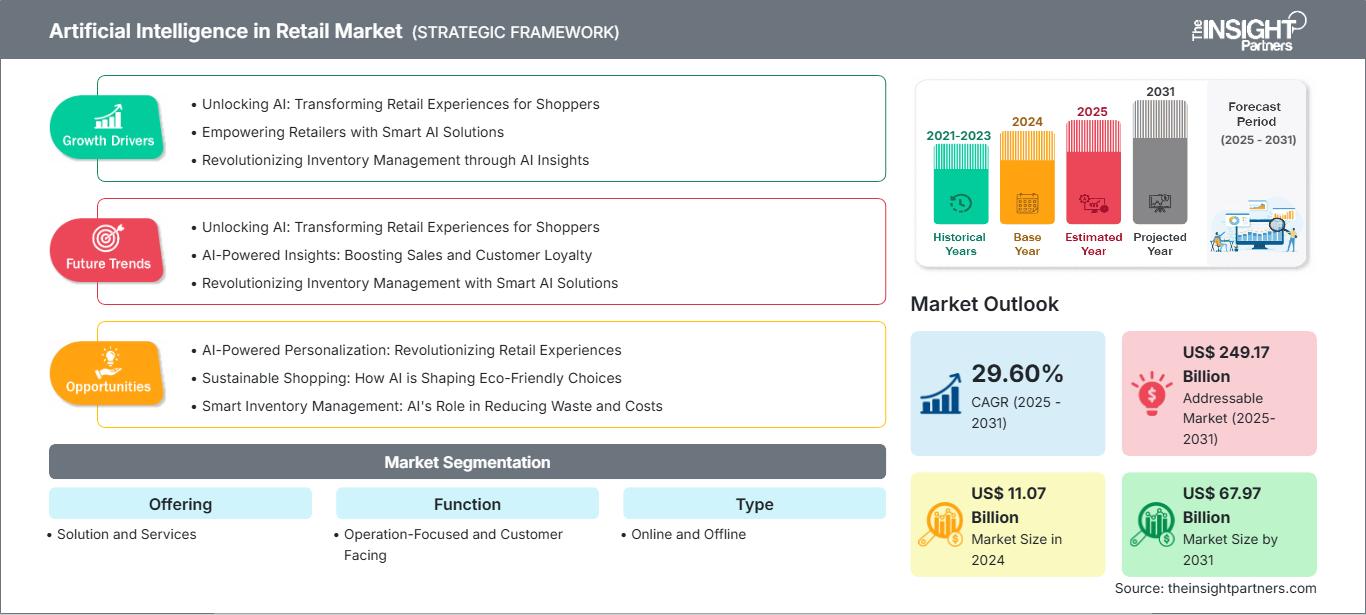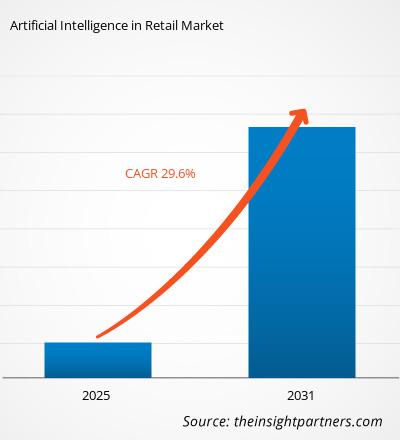소매업 인공지능 시장 규모는 2031년까지 862억 6천만 달러에 이를 것으로 예상됩니다. 2025년부터 2031년까지 연평균 성장률(CAGR)은 24.4%에 이를 것으로 예상됩니다.
본 보고서는 제공 분야(솔루션 및 서비스)별로 분류하고, 기능(운영 중심 및 고객 중심)을 기준으로 시장을 심층 분석합니다. 또한 유형(온라인 및 오프라인)과 산업 응용 분야(예측 분석, 매장 내 영상 모니터링 및 감시, 고객 관계 관리, 시장 예측, 재고 관리)별로 시장을 분석합니다. 각 주요 세그먼트에 대해 글로벌, 지역 및 국가별로 종합적인 분석이 제공됩니다. 본 보고서는 모든 세그먼트의 시장 규모와 전망을 포함하며, 가치는 미화(USD)로 표시됩니다. 또한 주요 업체의 현재 시장 현황에 대한 주요 통계와 함께 주요 시장 동향 및 새로운 기회에 대한 통찰력을 제공합니다.
보고서의 목적
The Insight Partners의 "소매 시장의 인공지능" 보고서는 현재 상황과 미래 성장, 주요 추진 요인, 과제 및 기회를 설명하는 것을 목표로 합니다. 이를 통해 다음과 같은 다양한 비즈니스 이해관계자에게 통찰력을 제공할 수 있습니다.
- 기술 제공업체/제조업체: 변화하는 시장 역학을 이해하고 잠재적인 성장 기회를 파악하여 정보에 입각한 전략적 의사 결정을 내릴 수 있도록 지원합니다.
- 투자자: 시장 성장률, 시장 재무 전망 및 가치 사슬 전반에 존재하는 기회에 대한 포괄적인 추세 분석을 수행합니다.
- 규제 기관: 시장 내 정책 및 단속 활동을 규제하여 남용을 최소화하고 투자자의 신뢰를 유지하며 시장의 건전성과 안정성을 유지합니다.
소매 시장 세분화를 위한 인공 지능 제공
- 솔루션 및 서비스
기능
- 운영 중심 및 고객 중심
유형
- 온라인 및 오프라인
응용 프로그램
- 예측 분석
- 매장 내 시각적 모니터링 및 감시
- 고객 관계 관리
- 시장 예측
- 재고 관리
이 보고서의 일부, 국가 수준 분석, Excel 데이터 팩을 포함하여 모든 보고서에 대한 사용자 정의를 무료로 받을 수 있을 뿐만 아니라 스타트업 및 대학을 위한 훌륭한 제안 및 할인을 이용할 수 있습니다
소매 시장의 인공지능: 전략적 통찰력

-
이 보고서의 주요 주요 시장 동향을 확인하세요.이 무료 샘플에는 시장 동향부터 추정 및 예측에 이르기까지 데이터 분석이 포함됩니다.
소매 시장 성장 동력의 인공 지능
- AI 활용: 쇼핑객을 위한 소매 경험 혁신
- 스마트 AI 솔루션으로 소매업체 역량 강화
- AI 통찰력을 통한 재고 관리 혁신
소매 시장 미래 동향의 인공 지능
- AI 활용: 쇼핑객을 위한 소매 경험 혁신
- AI 기반 통찰력: 판매 및 고객 충성도 향상
- 스마트 AI 솔루션으로 재고 관리 혁신
소매 시장 기회의 인공 지능
- AI 기반 개인화: 소매 경험 혁신
- 지속 가능한 쇼핑: AI가 친환경적 선택을 형성하는 방식
- 스마트 재고 관리: 폐기물 감소에 있어 AI의 역할 비용
소매 시장의 인공지능
The Insight Partners의 분석가들은 예측 기간 동안 소매업 인공지능 시장에 영향을 미치는 지역별 동향과 요인을 면밀히 분석했습니다. 이 섹션에서는 북미, 유럽, 아시아 태평양, 중동 및 아프리카, 중남미 지역의 심장 리듬 질환 관리 시장 부문 및 지역별 현황도 살펴봅니다.
소매 시장 보고서의 인공지능 범위
| 보고서 속성 | 세부 |
|---|---|
| 시장 규모 2024 | US$ XX Billion |
| 시장규모별 2031 | US$ 86.26 Billion |
| 글로벌 CAGR (2025 - 2031) | 24.4% |
| 이전 데이터 | 2021-2023 |
| 예측 기간 | 2025-2031 |
| 다루는 세그먼트 |
By 제공
|
| 포함된 지역 및 국가 |
북미
|
| 시장 선도 기업 및 주요 회사 프로필 |
|
소매 시장 참여자 밀도에서의 인공지능: 비즈니스 역학에 미치는 영향 이해
소매 시장에서 인공지능은 빠르게 성장하고 있으며, 이는 소비자 선호도 변화, 기술 발전, 그리고 제품 이점에 대한 인식 제고 등의 요인으로 인한 최종 사용자 수요 증가에 기인합니다. 수요가 증가함에 따라 기업들은 제품 및 서비스 확장, 소비자 니즈 충족을 위한 혁신, 그리고 새로운 트렌드를 적극 활용하고 있으며, 이는 시장 성장을 더욱 가속화하고 있습니다.

- 을 얻으세요 소매 시장의 인공지능 주요 주요 플레이어 개요
주요 판매 포인트
- 포괄적인 범위: 본 보고서는 소매업 인공지능 시장의 제품, 서비스, 유형 및 최종 사용자에 대한 분석을 포괄적으로 다루어 전체적인 전망을 제공합니다.
- 전문가 분석: 본 보고서는 업계 전문가 및 분석가의 심층적인 이해를 바탕으로 작성되었습니다.
- 최신 정보: 본 보고서는 최신 정보 및 데이터 동향을 포괄하여 비즈니스 관련성을 보장합니다.
- 맞춤 설정 옵션: 본 보고서는 특정 고객 요구 사항과 비즈니스 전략에 맞춰 맞춤 설정할 수 있습니다.
따라서 소매업 인공지능 시장 연구 보고서는 업계 상황과 성장 전망을 해석하고 이해하는 데 도움이 될 수 있습니다. 몇 가지 우려 사항이 있을 수 있지만, 본 보고서의 전반적인 이점은 단점보다 훨씬 큰 경향이 있습니다.
- 과거 분석(2년), 기준 연도, CAGR을 포함한 예측(7년)
- PEST 및 SWOT 분석
- 시장 규모 가치/거래량 - 글로벌, 지역, 국가
- 산업 및 경쟁 환경
- Excel 데이터세트
최근 보고서
사용 후기
구매 이유
- 정보에 기반한 의사 결정
- 시장 역학 이해
- 경쟁 분석
- 고객 인사이트
- 시장 예측
- 위험 완화
- 전략 기획
- 투자 타당성 분석
- 신흥 시장 파악
- 마케팅 전략 강화
- 운영 효율성 향상
- 규제 동향에 발맞춰 대응






















 무료 샘플 받기 - 소매 시장의 인공지능
무료 샘플 받기 - 소매 시장의 인공지능